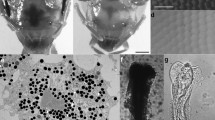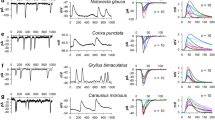Summary
Low vitamin A rearing decreases sensitivity and eliminates the ultraviolet but not the blue sensitivity maximum in R1-6 inDrosophila, Calliphora andMusca (Figs. 2–4). Spectral adaptation functions for control and vitamin A deprived flies yielded derived stable metarhodopsin absorption spectra from spectral sensitivity. Metarhodopsin has a long wavelength maximum and also has an ultraviolet maximum especially in the normal vitamin A condition (Figs. 2–4). M-potentials (fast early-receptor-like potentials) were obtained (Fig. 1) from all three genera in normal vitamin A rearing and were used for spectral adaptation studies (Figs. 2–3); the latter data are approximate inverses of sensitivity based spectral adaptation data. Thus, sensitivity must reflect proportion of rhodopsin, with metarhodopsin being inert in receptor potential generation.
Vitamin A effects on spectral functions were further investigated inDrosophila. Ultraviolet (370 nm) and visible (470 nm) sensitivities varied approximately linearly with dietary vitamin A dose (Fig. 5); 370 nm sensitivity decreased more than 470 nm sensitivity at lower doses. Increasing adaptation intensities of 370 and 470 nm caused parallel decreases in spectral sensitivity assayed at 370 and 470 nm in normal vitamin A flies (Fig. 6); the adapting intensities were sufficient to convert photopigment. These and previous results suggest that the two R1-6 spectral peaks are ultimately mediated by one rhodopsin. R1-6 rhabdomeres were structurally similar in high and low vitamin A flies but emitted a long wavelength fluorescence to ultraviolet excitation in high vitamin A flies only (Fig. 7). These results suggest some form of energy transfer; i.e., a carotenoid may capture ultraviolet quanta and transfer energy to rhodopsin via inductive resonance. Spectral adaptation data are consistent with a calculated high rhabdomeric optical density of ECL=0.26 (i.e., 45% of incident light is absorbed) derived from presently available data onDrosophila. Calculations show electro-retinographic sensitivity to be extremely high, perhaps measurable at less than one absorbed quantum per rhabdomere.
Similar content being viewed by others
References
Carlson, S.D., Sleeves, H.R., Vande-Berg, J.S., Robbins, W.E.: Vitamin A deficiency: effect on retinal structure of the mothManduca sexta. Science158, 268–270 (1967)
Cosens, D.: Some factors affecting the rate of dark adaptation in certain insects. J. Insect Physiol.17, 955–968 (1971)
Dartnall, H.J.A.: The interpretation of spectral sensitivity curves. Brit. med. Bull.9, 24–30 (1953)
Doane, W.W.:Drosophila. In: Methods in developmental biology (ed). F.H. Wilt, N.K. Wessels. New York: Thomas Crowell Co. 1967
Franceschini, N.: Sampling of the visual environment by the compound eye of the fly: fundamentals and applications. In: Photoreceptor optics (ed. A.W. Snyder, R. Menzel). Berlin-Heidelberg-New York: Springer 1975
Franceschini, N., Kirschfeld, K.: Etude optique in vivo des éléments photorecepteurs dans l'oeil composé deDrosophila. Kybernetik8, 1–13 (1971)
Goldsmith, T.H., Bernard, G.D.: The visual system of insects. In: Physiology of insecta, Vol. II, 2nd ed. (ed. M. Rockstein). New York: Academic Press 1974
Goldsmith, T.H., Fernandez, H.R.: Some photochemical and physiological aspects of visual excitation in compound eyes. In: The functional organization of the compound eye (ed. C.G. Bernhard). Oxford-New York: Pergamon Press 1966
Goldstein, E.B., Williams, T.D.: Calculated effects of “screening pigments.” Vision Res.6, 39–50 (1966)
Guzzo, A.V., Pool, G.L.: Visual pigment fluorescence. Science159, 312–314 (1968)
Hagins, W.A., Jennings, W.H.: Radiationless migration of electronic excitation in retinal rods. Faraday Soc. Disc.27, 180–190 (1959)
Hamdorf, K., Paulsen, R., Schwemer, J.: Photoregeneration and sensitivity control of photoreceptors of invertebrates. In: Biochemistry and physiology of visual pigments (ed. H. Langer). Berlin-Heidelberg-New York: Springer 1973
Hamdorf, K., Rosner, G.: Adaptation und Photoregeneration im Fliegenauge. J. comp. Physiol.86, 281–292 (1973)
Harris, W.A., Ready, D.F., Lipson, E.D., Hudspeth, A.J., Stark, W.S.: Vitamin A deprivation andDrosophila photopigments. Nature, in press (1977)
Harris, W.A., Stark, W.S.: Hereditary retinal degeneration inDrosophila melanogaster: a mutant defect associated with the phototransduction process. J. gen. Physiol.69, 261–291 (1977)
Harris, W.A., Stark, W.S., Walker, J.A.: Genetic dissection of the photoreceptor system in the compound eye ofDrosophila melanogaster. J. Physiol. (Lond.)256, 415–439 (1976)
Hecht, S., Schlaer, S., Pirenne, M.H.: Energy, quanta and vision. J. gen. Physiol.25, 819–840 (1942)
Heisenberg, M.: Separation of receptor and lamina potentials in the electroretinogram of normal and mutantDrosophila. J. exp. Biol.55, 85–100 (1971)
Horridge, G.A., Mimura, K.: Fly photoreceptors. I. Physical separation of the two visual pigments inCalliphora retinula cells 1–6. Proc. Roy. Soc. Lond. B190, 211–224 (1975)
Kirschfeld, K., Franceschini, N.: Photostable pigments within the membrane of photoreceptors and their possible role. Biophys. Struct. Mechanism3, 191–194 (1977)
Minke, B., Wu, C.-F., Pak, W.L.: Isolation of light induced response of the central retinula cells from the electroretinogram ofDrosophila J. comp. Physiol.98, 345–355 (1975)
Moore, T.A., Song, P.-S.: Molecular interactions in the ground and excited states of retinal. Nature New Biol.243, 30–32 (1973)
Muijser, H., Leutscher-Hazelhoff, J.T., Stavenga, D.G., Kuiper, J.W.: Photopigment conversions expressed in receptor potential and membrane resistance of blowfly visual sense cells. Nature (Lond.)254, 520–522 (1975)
Ostroy, S.E., Wilson, M., Pak, W.L.:Drosophila rhodopsin: photochemistry, extraction and differences in thenorp AP 12 phototransduction mutant. Biochem. biophys. Res. Commun.59, 960–966 (1974)
Pak, W.L., Liddington, K.J.: Fast electrical potential from a long-lived, long-wavelength photoproduct of fly visual pigment. J. gen. Physiol.63, 740–756 (1974)
Razmjoo, S., Hamdorf, K.: Visual sensitivity and the variation of total photopigment content in the blowfly photoreceptor membrane. J. comp. Physiol.105, 279–286 (1976)
Ready, D.F., Hanson, T.E., Benzer, S.: Development of theDrosophila retina, a neurocrystalline lattice. Dev. Bio.53, 217–240 (1976)
Rosner, G.: Adaptation und Photoregeneration im Fliegenauge. J. comp. Physiol.102, 269–295 (1975)
Shaw, S.R.: Retinal resistance barriers and electrical lateral inhibition. Nature255, 480–483 (1975)
Snyder, A.W., Pask, C.: Spectral sensitivity of dipteran retinula cells. J. comp. Physiol.84, 59–76 (1973)
Stark, W.S.: Spectral selectivity of visual response alterations mediated by interconversions of native and intermediate photopigments inDrosophila. J. comp. Physiol.96, 343–356 (1975)
Stark, W.S.: Diet, vitamin A and vision inDrosophila.Dros. Inform. Serv.52, 47–48 (1977a)
Stark, W.S.: Sensitivity and adaptation in R7, an ultraviolet photoreceptor, in theDrosophila retina. J. comp. Physiol.115, 47–59 (1977b)
Stark, W.S., Clark, A.W.: Visual synaptic structure in normal and blindDrosophila.Dros. Inform. Serv.50, 105 (1973)
Stark, W.S., Ivanyshyn, A., Hu, K.G.: Spectral sensitivities and photopigments in adaptation of fly visual receptors. Naturwissenschaften63, 513–518 (1976)
Stark, W.S., Wasserman, G.S.: Temporal properties of the ERG on-transient recorded in the retina and lamina.Dros. Inform. Serv.49, 63 (1972)
Stark, W.S., Wasserman, G.S.: Wavelength-specific ERG characteristics of pigmented- and whiteeyed strains ofDrosophila. J. comp. Physiol.91, 427–441 (1974)
Stark, W.S., Zitzmann, W.G.: Isolation of adaptation mechanisms and photopigment spectra by vitamin A deprivation inDrosophila. J. comp. Physiol.105, 15–27 (1976)
Stavenga, D.G.: Fly visual pigment. Difference in visual pigments of blowfly and dronefly peripheral retinula cells. J. comp. Physiol.111, 137–152 (1976)
Watt, B.K., Merrill, A.L.: Composition of Foods. United States Department of Agriculture: Washington, D.C. 1963
Wright, R., Cosens, D.: Blue-adaptation and orange-adaptation in white-eyedDrosophila: Evidence that the prolonged afterpotential is correlated with the amount of M580 in R1-6. J. comp. Physiol.113, 105–128 (1977)
Wu, C.-F., Pak, W.L.: Quantal basis of photoreceptor spectral sensitivity ofDrosophila melanogaster. J. gen. Physiol.66, 149–168 (1975)
Author information
Authors and Affiliations
Additional information
Supported by NSF grants BMS-74-12817 and BNS-76-11921. We thank M. Chapin, K. Hu, D. Lakin, G. Pransky, D. Sawyer and W. Zitzmann for technical assistance. We are indebted to numerous colleagues especially W. Harris, for comments and suggestions.Chalky Calliphora were obtained from the laboratories of Dr. G. McCann at Caltech and Dr. L. Bishop at the University of Southern California.W-II Musca were from Dr. D. Wagoner at the U.S.D.A. in Fargo, North Dakota.
Rights and permissions
About this article
Cite this article
Stark, W.S., Ivanyshyn, A.M. & Greenberg, R.M. Sensitivity and photopigments of R1-6, a two-peaked photoreceptor, inDrosophila, Calliphora andMusca . J. Comp. Physiol. 121, 289–305 (1977). https://doi.org/10.1007/BF00613010
Received:
Issue Date:
DOI: https://doi.org/10.1007/BF00613010




